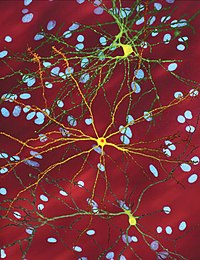
Photo from wikipedia
Genetic diseases are the most common next-generation diseases because of the improper mutation of the genes and DNA. These genetic diseases are failed to predict with an accurate manner in… Click to show full abstract
Genetic diseases are the most common next-generation diseases because of the improper mutation of the genes and DNA. These genetic diseases are failed to predict with an accurate manner in the beginning stage by using the particular genes and related information. So, the genetic diseases are identified in the medical systems by utilizing the hybridization of multimedia techniques such as big data and related soft computing techniques.Initially, the genetic disease-related medical images are collected from healthcare sectors, and from the genetic image, various genetic data are collected from the large amount of datasets in which the major challenge is too high dimensionality that increases the complexity of the genetic disease prediction system. So, in this paper the complexity of the system is reduced by using the associative decision tree-based learning and Hopfield dynamic neural networks (HDNN). After collecting the data from the various resources, the immune clonal selection algorithm approach is used to remove inconsistent data and minimize the dimensionality of data. The selected features are trained by the proposed associative decision tree approach which helps to compare with the testing features using the HDNN that successfully recognize the genetic disease-based features effectively. The excellence of the system is measured with the aid of the experimental outcomes that are corresponding to the forecasting methods such as greedy algorithm, rough set method and artificial bee colony, and the comparison is made with the avail of the accuracy, sensitivity and specificity.
Journal Title: Neural Computing and Applications
Year Published: 2019
Link to full text (if available)
Share on Social Media: Sign Up to like & get
recommendations!